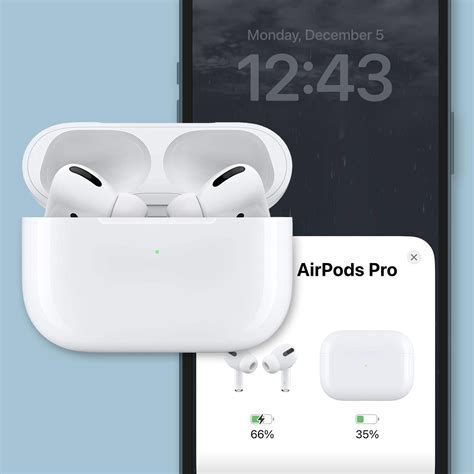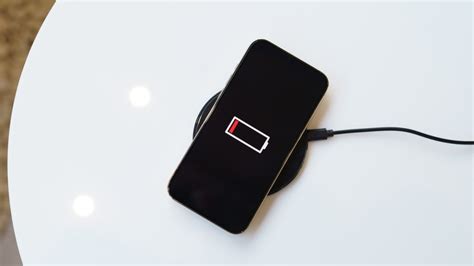Have you ever experienced the frustration of your sleek, cord-free earbuds losing battery power faster than you expected? We all strive for convenience and mobility when it comes to our gadgets, but sometimes it seems like there's a discrepancy between expectation and reality. Understanding the underlying reasons behind the rapid discharge of wireless earbuds can shed light on this common issue, helping us make more informed choices in the future.
Power Drain: The Culprit Behind Limited Battery Life
When we rely on wireless earbuds for our favorite tunes or uninterrupted calls, it's crucial to comprehend the conditions that contribute to their lackluster battery performance. The essential factor affecting their power drain is the energy-intensive process of transmitting audio wirelessly. The wireless technology employed in these modern earbuds demands a constant flow of power to maintain a seamless connection between the devices, resulting in a significantly quicker battery consumption than traditional wired headphones.
Efficiency: A Battle of Trade-Offs
While wireless earbuds offer unmatched freedom of movement, they also come with their fair share of compromises in terms of battery efficiency. In the quest for compactness and sleek design, manufacturers often face the challenge of fitting a powerful battery into a small form factor. Striking the perfect balance between size and power capacity is a constant trade-off. As a result, the limited physical space available for batteries inevitably influences the longevity of these devices, ultimately resulting in quicker power depletion compared to their wired counterparts.
Factors Affecting the Battery Life of Airpods

The battery life of wireless headphones, such as the popular Airpods, can be influenced by various factors that contribute to their quick discharge. Understanding these common factors can help users optimize the usage and maximize the battery life of their wireless headphones.
| Factors | Impact on Battery Life |
|---|---|
| Volume Level | The higher the volume, the more power is consumed, leading to faster battery drain. Maintaining a moderate volume level can help prolong the battery life. |
| Connected Devices | Having multiple devices connected to the Airpods simultaneously, such as smartphones, tablets, or laptops, can significantly drain the battery. Disconnecting unused devices can help conserve power. |
| Audio Quality | Playing music or content with higher audio quality, such as lossless audio or high-definition streaming, can require more processing power from the Airpods, resulting in faster battery discharge. |
| Usage Patterns | The duration and frequency of using the Airpods impact the battery life. Extended periods of continuous usage or frequent short bursts of usage can contribute to quicker battery drain. |
| Environmental Factors | Extreme temperatures, both hot and cold, can affect the battery performance of wireless headphones. Using Airpods within the recommended temperature range can help maintain optimal battery life. |
| Battery Age | Over time, the capacity of the Airpods' battery may decrease, resulting in reduced battery life. Regularly replacing older batteries can help ensure longer usage time. |
By considering and managing these factors, users can take proactive steps to extend the battery life of their Airpods wireless headphones and enjoy uninterrupted usage for longer durations.
Battery Age and Wear
When it comes to the longevity of wireless earbuds' battery life, one crucial factor to consider is the battery age and wear. Over time, like any other electronic device, the batteries in wireless headphones experience degradation and eventually lose their ability to hold a charge efficiently.
As batteries age, their capacity to store and deliver power diminishes, resulting in a decrease in the overall battery life. This natural process occurs due to chemical reactions happening inside the battery cells, leading to the deterioration of their internal components.
Factors such as temperature exposure, usage habits, and charging patterns also play a significant role in the aging process of wireless headphone batteries. Exposure to extreme temperatures, whether excessively hot or cold, can accelerate the degradation of the battery life. Additionally, continuous and repetitive charging cycles can lead to wear and tear on the battery cells, reducing their overall performance.
Proper maintenance and care can help slow down the aging process of the battery in wireless earbuds. Avoiding extreme temperature conditions and following the manufacturer's recommended guidelines for charging can help maximize the longevity of the battery. It is also advisable to avoid overcharging or completely draining the battery, as this can put unnecessary strain on the cells.
In conclusion, the battery age and wear are vital considerations when it comes to the quick discharge of wireless earbuds. Understanding the natural degradation process and implementing proper care guidelines can help prolong the battery life and ensure optimal performance over time.
Excessive Usage and Power Consumption

One of the factors that can contribute to the rapid depletion of battery life in wireless headphones is excessive usage and high power consumption.
Regular and prolonged usage of wireless headphones can result in a significant drain on the battery. The more frequently and intensively the headphones are used, the quicker the battery will discharge. This is particularly true when you are using features that require more power, such as noise cancellation or high volume levels.
When using wireless headphones, it is important to be mindful of their battery life and plan your usage accordingly. If you constantly use your headphones throughout the day without giving them a chance to recharge, it is only natural that the battery will drain quickly.
- Reduce the usage time: Limit your usage to conserve battery life and make it last longer. Consider using your headphones only when necessary or using them in short intervals instead of continuous usage.
- Optimize power settings: Some wireless headphones come with power-saving modes or adjustable power settings. Take advantage of these features to optimize the power consumption of your headphones.
- Avoid unnecessary features: Certain features, such as noise cancellation or excessive bass, can consume more power. If battery life is a concern, try disabling or reducing the use of these features.
- Keep firmware updated: Manufacturers often release firmware updates that can improve the efficiency and power management of wireless headphones. Make sure to regularly check for any available updates and install them.
- Proper storage and care: When not in use, it is important to properly store your wireless headphones in a case and avoid exposing them to extreme temperatures. Additionally, keeping the headphones clean and free from dirt and debris can help maintain their performance and battery life.
By being mindful of your usage habits, optimizing power settings, and taking care of your wireless headphones, you can help extend their battery life and reduce the rapid discharge that may occur with excessive usage.
Bluetooth Connectivity Issues
In the realm of wireless audio devices, a significant aspect that merits attention is the matter of Bluetooth connectivity. The smooth and uninterrupted connection between devices plays a crucial role in ensuring a seamless audio experience. Therefore, it is imperative to discuss potential challenges and issues that may arise concerning Bluetooth connectivity with wireless headphones. Understanding these problems can shed light on the reasons for any hitches in the overall performance.
Challenges with Pairing: One of the primary concerns users might face is the difficulty in pairing their wireless headphones with their desired device. Pairing issues can cause frustration and hinder the seamless connection between the headphones and the user's audio source. These challenges might stem from various factors such as incompatible Bluetooth versions, firmware glitches, or interference from other nearby devices.
Signal Interference: Another common problem encountered with Bluetooth connectivity is signal interference. This issue often arises in environments where multiple devices are operating on the same frequency or in areas with a high concentration of wireless signals. Signal interference can lead to audio interruptions, reduced range, or even complete disconnection between the wireless headphones and the audio source.
Software Compatibility: In certain cases, Bluetooth connectivity problems may arise due to compatibility issues between the wireless headphones and the device's software. Software updates or outdated firmware in either the headphones or the audio source may result in glitches, pairing failures, or unstable connections. Ensuring that both the devices are running the latest software versions can help mitigate such issues.
Physical Obstructions: Physical obstacles, such as walls, furniture, or other objects, can obstruct the Bluetooth signal and weaken the connectivity between the wireless headphones and the audio source. This can result in reduced range or signal dropouts, leading to an inconsistent audio experience. Being mindful of the positioning and distance between devices can alleviate these problems.
Environmental Factors: Environmental factors, like radio frequency interference or electromagnetic fields in the surroundings, can interfere with Bluetooth connectivity. Devices operating in close proximity to Wi-Fi routers, microwave ovens, or other electronic appliances emitting similar frequencies may experience disruptions in signal strength. Identifying and minimizing exposure to such environmental factors can contribute to better Bluetooth connectivity.
In summary, Bluetooth connectivity issues can manifest in various forms, ranging from pairing difficulties and signal interference to software compatibility and physical obstructions. Recognizing and troubleshooting these problems can aid in resolving connectivity-related complications with wireless headphones, enhancing the overall user experience.
Inefficient Charging Habits

When it comes to the topic of why wireless headphones experience a rapid decline in battery life, one important factor to consider is inefficient charging habits. Understanding how to properly charge and maintain your wireless headphones can have a significant impact on their overall battery performance and longevity.
One common mistake that many users make is leaving their headphones connected to the charger for an extended period of time after they have reached full battery capacity. This can actually be detrimental to the battery's health, as it may lead to overcharging and increased wear and tear. It is recommended to unplug your headphones from the charger once they are fully charged to avoid unnecessary strain on the battery.
Another inefficient charging habit to be mindful of is using an improper charging cable or adapter. It is essential to use the original charging accessories that came with your wireless headphones or a reputable third-party option that is compatible with your device. Using incompatible or low-quality charging accessories can result in slower charging speeds and ineffective power transfer, ultimately leading to shorter battery life and quicker discharges.
Additionally, repeatedly allowing your wireless headphones to fully drain their battery before recharging can also contribute to their rapid discharge. Lithium-ion batteries, which are commonly used in wireless headphones, perform best when they are regularly topped up with partial charges rather than being completely discharged and then recharged. This charging method, known as shallow or partial charging, helps to preserve the battery's overall capacity and prolong its lifespan.
- Always remember to store your wireless headphones in a cool, dry place when not in use, as extreme temperatures can negatively affect their battery life.
- Regularly clean your charging port and connectors to ensure a proper charging connection and optimize charging efficiency.
- Avoid using your headphones while they are charging, as this can generate excess heat and potentially damage the battery.
By developing efficient charging habits and taking proper care of your wireless headphones, you can maximize their battery performance and enjoy longer listening sessions without the need for frequent recharges.
Software and Firmware Bugs
In the context of the discussed topic of the rapid battery drainage in wireless earbuds, it is essential to address the potential role of software and firmware bugs. These issues can significantly impact the battery life and overall performance of any electronic device, including wireless headphones. Software and firmware bugs refer to errors or flaws in the coding or programming of the device's operating system or its firmware. These bugs can lead to various malfunctions and inefficiencies, affecting the power management system and resulting in increased power consumption.
One of the common software or firmware bugs that can contribute to fast battery drainage is a background process or application that utilizes an excessive amount of system resources. Such processes may continuously run in the background, consuming power even when the device is not actively in use. These resource-intensive activities can drain the battery quickly and may be difficult to identify without the proper diagnostics tools.
Another potential bug is related to power-management algorithms implemented in the software or firmware. These algorithms are responsible for regulating power usage by optimizing various functions and features of the device. However, if there are errors in these algorithms, they can lead to inefficient power management, causing the device to consume more power than necessary. This can result in a shortened battery life and a quick discharge of the wireless headphones.
Furthermore, software and firmware bugs can also affect the accuracy of battery level reporting. When a bug exists in the code responsible for monitoring and displaying the battery level, it can lead to inaccurate information being shown to the user. This can create confusion and uncertainty about the actual battery status, potentially leading to unexpected discharges and the perception of rapid battery drainage.
To address these software and firmware bugs, manufacturers frequently release updates and patches. These updates aim to fix known issues, improve device performance, and enhance power management capabilities. It is crucial for users to regularly check for and install these updates to ensure their wireless headphones are running the latest software or firmware version, potentially resolving any bugs that could be causing rapid battery discharge.
| Software and Firmware Bugs |
|---|
| Background processes or applications utilizing excessive system resources |
| Errors in power-management algorithms |
| Inaccurate battery level reporting |
| Importance of software and firmware updates |
FAQ
Why do Airpods wireless headphones discharge quickly?
Airpods wireless headphones may discharge quickly due to several reasons. One possible reason is that the battery of the Airpods is already degraded or worn out, which is a common issue with lithium-ion batteries over time. Another reason could be the frequent use of the Airpods, especially if they are used for long durations without giving them sufficient time to charge in between. Additionally, if the Airpods are connected to a device with a poor Bluetooth connection, they may consume more battery power to maintain a stable connection.
Is it normal for Airpods wireless headphones to have a short battery life?
No, it is not normal for Airpods to have a short battery life. Apple claims that a fully charged pair of Airpods can last up to 5 hours of listening time or up to 3 hours of talk time. However, factors like volume level, the type of audio content being played, and the age of the battery can affect the actual battery life. If the Airpods consistently have a short battery life that does not align with Apple's claims, it could be an indication of a problem or degraded battery.
What can I do to improve the battery life of my Airpods?
To improve the battery life of your Airpods, you can try several methods. Firstly, make sure to fully charge the Airpods before using them and avoid using them until they are completely drained. It is recommended to use the Airpods at moderate volume levels rather than at maximum volume, as higher volume levels can drain the battery more quickly. You can also disable unnecessary features like active noise cancellation if you are not using them. Lastly, try to keep the Airpods and the device they are connected to close to each other to ensure a strong Bluetooth connection, as weak connections can lead to increased battery consumption.
Can I replace the battery of my Airpods?
The battery of Airpods is not designed to be user-replaceable. Airpods are built with a small lithium-ion battery that is integrated into the design of the device and is not easily accessible. If you are experiencing significant battery degradation or a short battery life, it is recommended to contact Apple Support or visit an authorized service center to assess the issue and determine if a battery replacement is necessary.
Are there any alternatives to Airpods with longer battery life?
Yes, there are several alternatives to Airpods that offer longer battery life. Many other brands offer wireless earbuds with extended battery life, such as the Sony WF-1000XM4, Jabra Elite 75t, or Samsung Galaxy Buds Pro. These alternatives often come with their own unique features and advantages, so it is recommended to research and compare different options based on your specific needs and preferences.
Why do Airpods wireless headphones discharge quickly?
There are several reasons why Airpods wireless headphones may discharge quickly. One possible reason is that the battery capacity may have degraded over time, especially if the Airpods are old or have been used extensively. Another reason could be that the Airpods are not properly charging, which could be due to a faulty charging cable or a problem with the charging case. Additionally, the battery life of Airpods can be affected by factors such as high usage, playing audio at a loud volume, or using features like noise cancellation. It is also important to consider that battery life can vary depending on the specific model of Airpods.
What can I do to prevent my Airpods from discharging quickly?
To prevent your Airpods from discharging quickly, there are several steps you can take. Firstly, make sure that you are using a genuine charging cable and adapter to charge your Airpods. Using third-party accessories may not provide the same level of charging efficiency. Additionally, try to avoid keeping your Airpods connected to your device when they are not in use, as this can drain the battery. It is also recommended to keep your Airpods in their charging case when not in use, as this helps to maintain their battery levels. Furthermore, adjusting settings such as reducing the volume level or turning off features like noise cancellation can also help conserve battery life. Finally, if you find that your Airpods are still draining quickly, it may be worth considering getting the battery replaced or seeking assistance from an authorized service provider.




